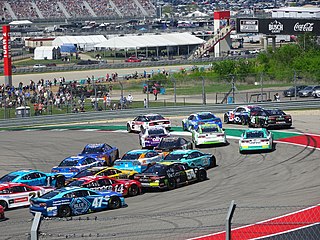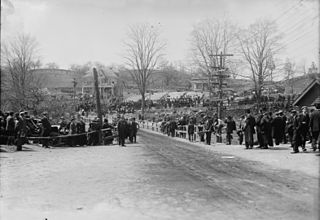
Auto racing is a motorsport involving the racing of automobiles for competition. In North America, the term is commonly used to describe all forms of automobile sport including non-racing disciplines.
The National Association for Stock Car Auto Racing, LLC (NASCAR) is an American auto racing sanctioning and operating company that is best known for stock car racing. It is considered to be one of the top ranked motorsports organizations in the world and is one of the largest spectator sports in America. The privately owned company was founded by Bill France Sr. in 1948, and his son, Jim France, has been the CEO since August 2018. The company is headquartered in Daytona Beach, Florida. Each year, NASCAR sanctions over 1,500 races at over 100 tracks in 48 US states, as well as in Canada, Mexico, Brazil and Europe.

Stock car racing is a form of automobile racing run on oval tracks and road courses measuring approximately 0.25 to 2.66 miles. It originally used production-model cars, hence the name "stock car", but is now run using cars specifically built for racing. It originated in the southern United States; its largest governing body is NASCAR. Its NASCAR Cup Series is the premier top-level series of professional stock car racing. Australia, Canada, New Zealand, Mexico, Brazil and the United Kingdom also have forms of stock car racing. Top-level races typically range between 200 and 600 miles in length.

Touring car racing is a motorsport road racing competition that uses race prepared touring cars. It has both similarities to and significant differences from stock car racing, which is popular in the United States.
Motorsport(s) or motor sport(s) are sporting events, competitions and related activities that primarily involve the use of automobiles, motorcycles, motorboats and powered aircraft. For each of these vehicle types, the more specific terms automobile sport, motorcycle sport, power boating and air sports may be used commonly, or officially by organisers and governing bodies.

A race track is a facility built for racing of vehicles, athletes, or animals. A race track also may feature grandstands or concourses. Race tracks are also used in the study of animal locomotion.

Road racing is a North American term to describe motorsport racing held on a paved road surface. The races can be held either on a closed circuit or on a street circuit utilizing temporarily closed public roads. The objective is to complete a predetermined number of circuit laps in the least amount of time, or to accumulate the most circuit laps within a predetermined time period. Originally, road races were held almost entirely on public roads. However, public safety concerns eventually led to most races being held on purpose-built racing circuits.

The Trans-Am Series presented by Pirelli is a sports car racing series held in North America. Founded in 1966, it is sanctioned by the Sports Car Club of America (SCCA). Primarily based in the United States, the series competes on a variety of track types including road courses and street circuits. Trans-Am is split into the TA and TA2 classes for silhouette racing cars, while its production classes are the GT, SGT, and XGT.

Ballot was a French manufacturer, initially of engines, that also made automobiles between 1919 and 1932. Édouard Ballot became well known as a designer of reliable engines. He helped Ettore Bugatti in developing his first engines.

Raffaele "Ralph" DePalma was an American racing driver who won the 1915 Indianapolis 500. His entry at the International Motorsports Hall of Fame estimates that he won about 2,000 races. DePalma won the 1908, 1909, 1910, and 1911 American AAA national dirt track championships and is credited with winning 25 American Championship car races. He won the Canadian national championship in 1929. DePalma estimated that he had earned $1.5 million by 1934 after racing for 27 years. He is inducted in numerous halls of fame. He competed on boards and dirt road courses and ovals.
The National Motor Vehicle Company was an American manufacturer of automobiles in Indianapolis, Indiana, between 1900 and 1924. One of its presidents, Arthur C. Newby, was also one of the investors who created the Indianapolis Motor Speedway.

Erwin George "Cannon Ball" Baker was an American motorcycle and automobile racer and organizer in the first half of the 20th century. Baker began his public career as a vaudeville performer, but turned to driving and racing after winning a dirt-track motorcycle race at Crawfordsville, Indiana, in about 1904.

Turismo Carretera is a popular stock car racing series in Argentina, and the oldest auto racing series still active in the world. The series is organized by Asociación Corredores de Turismo Carretera.
Phil Earl Shafer was an American racing driver and constructor.
The Chicago Motor Club, or CMC, is local chapter of the American Automobile Association in Chicago, Illinois. The CMC sponsored the first Elgin National Road Races in 1909. Growing from concern for the well-being of students walking to school, the CMC pioneered the concept of School Safety Patrols in 1920.

ASCAR (Anglo-American Stock Car Racing), was a stock car racing series that raced at circuits around the United Kingdom and Europe from 2001 until 2008. The series went through many guises during its seven year period and was known as the ASCAR Mintex Cup from 2001 to 2003, later known as the Days of Thunder Racing Series (2004) and the SCSA (Stock Car Speed Association) (2005 to 2007) before its final season as the SCSA MAC Tools VSR V8 Trophy. Although going through these varying identities the series was commonly referred to and known by its original name of ASCAR. The series predominantly raced the oval tracks at the Rockingham Motor Speedway and the EuroSpeedway Lausitz in the early years but in its final season in 2008 was solely road racing series that would visit various tracks in the UK most notably Brands Hatch and in France at Croix en Ternois. The series folded in 2008 and merged into part of the European Late Model Series in 2009, racing in Belgium and the UK.
Auto racing began in the mid-19th century. It became an organized sport in the early 20th century and has grown in popularity ever since.

The NASCAR Cup Series is the top racing series of the National Association for Stock Car Auto Racing (NASCAR). The series began in 1949 as the 'Strictly Stock Division', and from 1950 to 1970 it was known as the 'Grand National Division.' In 1971, when the series began leasing its naming rights to the R. J. Reynolds Tobacco Company, it was referred to as the 'NASCAR Winston Cup Series' (1971–2003). A similar deal was made with Nextel in 2003, and it became the 'NASCAR Nextel Cup Series' (2004–2007). Sprint acquired Nextel in 2005, and in 2008 the series was renamed the 'NASCAR Sprint Cup Series' (2008–2016). In December 2016, it was announced that Monster Energy would become the new title sponsor, and the series was renamed the 'Monster Energy NASCAR Cup Series' (2017–2019). In 2019, NASCAR rejected Monster's offer to extend the current naming rights deal beyond the end of the season. NASCAR subsequently announced its move to a new tiered sponsorship model beginning with the 2020 season similar to other US based professional sports leagues, where it was simply known as the 'NASCAR Cup Series', with the sponsors of the series being called Premier Partners. The four Premier Partners are Busch Beer, Coca-Cola, GEICO, and Xfinity.

The First American International Road Race, informally known as the Briarcliff Trophy Race, was a stock car race in Westchester County, New York, in April 1908. The race was sponsored by and centered around the village of Briarcliff Manor. The race was the first automobile race in Westchester and the first international stock car race in the United States.
The Merrimack Valley Course was a temporary street circuit in Lowell, Massachusetts. The 10.6 mile track hosted its first races in 1908 and was on the 1909 AAA Championship Car schedule. Due to financial losses, racing was discontinued after that season.














